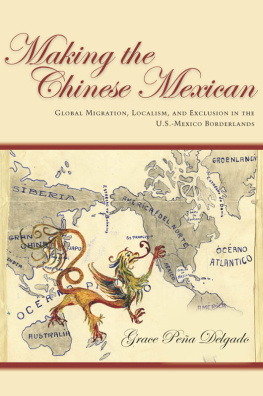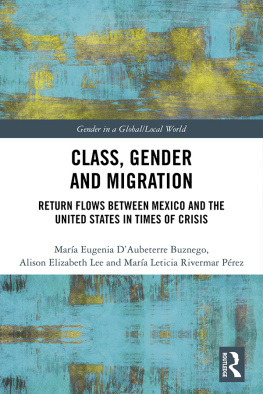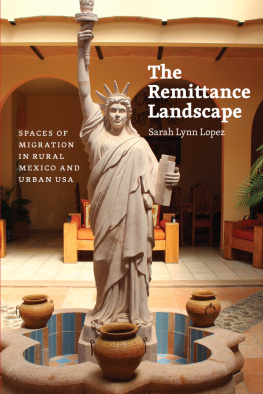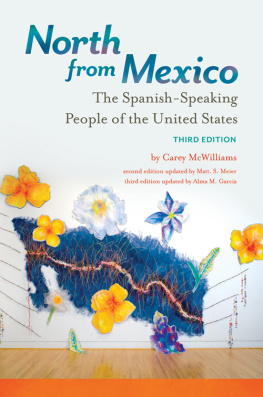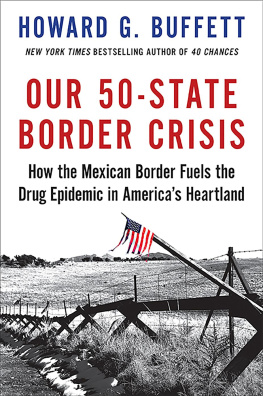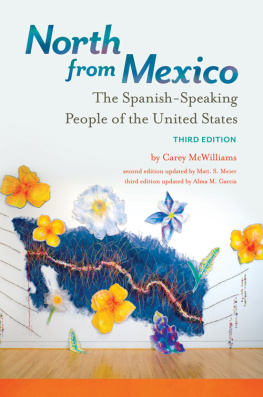Mexican Migration to the United States
Perspectives from Both Sides of the Border
EDITED BY HARRIETT D. ROMO AND OLIVIA MOGOLLON-LOPEZ

University of Texas Press
Austin
Copyright 2016 by the University of Texas Press
All rights reserved
First edition, 2016
Requests for permission to reproduce material from this work should be sent to:
Permissions
University of Texas Press
P.O. Box 7819
Austin, TX 78713-7819
http://utpress.utexas.edu/index.php/rp-form
Library of Congress Cataloging-in-Publication Data
Names: Romo, Harriett, editor. | Mogollon, O., editor.
Title: Mexican migration to the United States : perspectives from both sides of the border / edited by Harriett D. Romo and Olivia Mogollon-Lopez.
Description: First edition. | Austin : University of Texas Press, 2016. | Includes bibliographical references and index.
Identifiers: LCCN 2015037502 | ISBN 9781477308974 (cloth : alk. paper) | ISBN 9781477309025 (pbk. : alk. paper) | ISBN 9781477309667 (library e-book) | ISBN 9781477309674 (nonlibrary e-book)
Subjects: LCSH: MexicoEmigration and immigration. | MexicansUnited States. | ImmigrantsUnited States. | United StatesEmigration and immigrationGovernment policy. | United StatesEmigration and immigrationEconomic aspects. | United StatesEmigration and immigrationSocial conditions. | Return migrationMexico. | Emigrant remittances.
Classification: LCC E184.M5 M528 2016 | DDC 304.8/73072dc23
LC record available at http://lccn.loc.gov/2015037502
doi:10.7560/308974
Contents
HARRIETT D. ROMO
FRANCISCO ALBA
PIA M. ORRENIUS, JASON SAVING, AND MADELINE ZAVODNY
JORGE DURAND
LILIANA MEZA GONZLEZ AND MICHAEL FEIL
FRANK D. BEAN, SUSAN K. BROWN, AND JAMES D. BACHMEIER
ROBERTO G. GONZALES, JOANNA B. PEREZ, AND ARIEL G. RUIZ
KANDY MINK SALAS, HENOC PRECIADO, AND RAQUEL TORRES
MILENA ANDREA MELO AND K. JILL FLEURIET
HARRIETT D. ROMO AND OLIVIA MOGOLLON-LOPEZ
AGUSTN ESCOBAR LATAP
VCTOR ZIGA, EDMUND T. HAMANN, AND JUAN SNCHEZ GARCA
JANETH MARTINEZ
HARRIETT D. ROMO
Acknowledgments
We are grateful to the University of Texas at San Antonios Office of the Provost and UTSAs Vice President of Community Services, Dr. Jude Valdez, for funds that enabled the UTSA Mexico Center to organize a large conference on Mexico-US migration. This conference inspired the initiation of ongoing dialogue among scholars from Mexico and the United States whose work has focused on immigration, and these relationships led to this edited manuscript.
We would like especially to acknowledge Professor Katharine Donato for her careful reading of the manuscript and for her extremely helpful suggestions. We benefited greatly from the work of several graduate student researchers at the UTSA Mexico Center as we prepared this manuscript: Raquel Torres, Janeth Martinez, and Christina Lopez-Mobilia. We are also appreciative of the help of staff at the UTSA Mexico Center who pitched in when we needed extra assistancethank you, Alexandra Romero, Sophia Ortiz, and David Rodriguez.
We recognize that collected editions take a long time in review and publication, so we also recognize the patience and cooperation of the authors, reviewers, and editors at University of Texas Press as we moved through the process of requests for manuscripts, reviews, edits, and revisions. We have enjoyed working with you, and we hope this volume leads to rigorous discussion of immigration policies in both the United States and Mexico.
INTRODUCTION
Policies, Dynamics, and Consequences of Mexican Migration to the United States
HARRIETT D. ROMO
This volume presents the work of scholars from the United States and Mexico focusing on Mexican migration to the United States. The topic is one of long interest on both sides of the border and has been explored by many in academia. However, it is not often that we bring both Mexican and US scholars together to analyze these issues. Our aim is to present rational and empirically based discussions of key immigration policy issues from both a Mexican and US perspective. This volume incorporates empirical studies of labor markets, health, family adaptations, and educational processes related to incorporation of migrants in the United States and upon their return to Mexico. Such scholarship is needed to counter the many negative representations of immigrants and immigration that appear in the media.
The scholars included in this volume provide comprehensive research addressing the complex dynamics generating migration patterns and address human and political issues that both sending and receiving communities must accommodate. Theory and research have emphasized how economic and political forces shape the style, intensity, sanctions, and policies related to immigration. This volume includes policy essays, demographic assessments, analyses of immigration policy consequences, and ethnographic explorations of factors affecting migrants in the United States and the reincorporation of return migrants in Mexico. Several scholars included here are well known in the field of immigration studies and are presenting ideas drawn from their most recent work. Others are emerging scholars who bring fresh insights to the complexity of immigration processes and policies.
Mexico-US Migration: Legal Frameworks and Their Implications
In the months before the devastation by terrorists on September 11, 2001, Mexicos President Vicente Fox and US President George W. Bush had begun talks on migration. Expectations were high that long-term, mutually agreed-upon, bilateral strategies could be negotiated to regulate Mexico-US migration. In the following years, the United States experienced a deep economic recession, beginning during the Bush administration and continuing into the Obama administration, which caused high rates of unemployment in the United States and heightened US anti-immigration sentiment. US policy concerns turned to border security, the detention and deportation of undocumented immigrants, and prevention of additional terrorist attacks. Controlling undocumented immigration remained a deep concern.
According to Passel and Cohn (2011, 2014), just over half (51 percent) of all current Mexican immigrants in the United States are unauthorized, and some 52 percent of the estimated 11.2 million unauthorized immigrants are Mexican. Migration management is of primary importance for both countries, as is fair and credible enforcement of controls. Mexican and American government officials and scholars recognize that economic development in Mexico is a key component in reducing emigration and encouraging Mexicans to remain in Mexico. Passel, Cohn, and Gonzalez-Barrera (2012) have also stated that, along with decreasing birth rates, positive economic and social changes in Mexico are major factors in lessening the emigrant flows from Mexico.
Massey, Durand, and Pren (2014) confirm that economic conditions on both sides of the border have consistently fluctuated to increase or decrease undocumented migration over the past four decades, but economic incentives for unauthorized departure of Mexicans to the United States have not disappeared. Massey, Durand, and Pren (2014) claim that the sharp drop in Mexican childbearing and the rising age among household heads at risk of taking an undocumented trip to the United States have played a major role in the decline of Mexican migration. The magnitude of immigration from Mexico, the number of Mexican-origin persons living in the United States, and the long history of Mexico-US migration make it important to understand who comes, how, and whyand what impact US and Mexican policies have on those dynamics.
Next page

